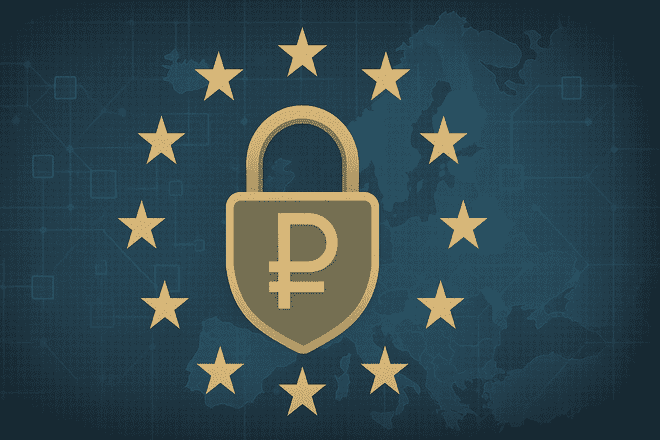The European Union is weighing EU sanctions on A7A5, a ruble backed stablecoin. Draft measures would bar EU persons from dealing with A7A5 directly or indirectly. Bloomberg reported the proposal, citing internal documents.
The move follows EU sanctions on Sept. 19 that tightened crypto restrictions for Russian residents.
Those steps also limited dealings with foreign banks tied to Russia. The European Council describes sanctions as tools to influence targeted conduct.
Stay ahead in the crypto world – follow us on X for the latest updates, insights, and trends!🚀
Any new EU sanctions require unanimous backing from all 27 member states.
Negotiations can change scope and timing before adoption. The current language addresses crypto pathways that could enable sanctions evasion.
A7A5 market cap surge and non USD stablecoin share
A7A5 saw a sharp market cap spike after the Sept. 19 actions. On Sept. 26, the figure jumped from about 140 million dollars to more than 491 million dollars. CoinMarketCap recorded the one day increase near 250 percent.
As of Monday, A7A5 holds near 500 million dollars in market cap. That is about 43 percent of all non USD stablecoins at roughly 1.2 billion dollars. The level places A7A5 as the largest non dollar stablecoin by size.
Circle EURC stands at around 255 million dollars. The contrast shows A7A5 ahead among non USD stablecoins. The numbers frame the market presence that EU sanctions now address.
Banks and exchanges in the firing line under EU sanctions
The draft also names banks in Russia, Belarus, and Central Asia. Reports say these banks enable crypto transactions for sanctioned actors. The package seeks to limit the financial plumbing behind such flows.
Earlier steps came from the United Kingdom and the United States in August.
Those measures cited parts of the financial sector used to bypass sanctions. Named parties included the Capital Bank of Central Asia and director Kantemir Chalbayev.
Sanctions lists also included Grinex and Meer, two Kyrgyzstan crypto exchanges.
The actions cover entities tied to infrastructure supporting the ruble backed stablecoin A7A5. The scope shows a widening focus across jurisdictions.
Who is behind A7A5 launch networks and stated reserves
A7A5 launched in February on Ethereum and Tron. Backers include Ilan Shor, a Moldovan banker, and Russia state lender Promsvyazbank. The team states that reserves sit as fiat deposits within Kyrgyzstan banks.
The project describes a diversified portfolio of deposits as backing. That model connects on chain issuance to off chain banking. The setup links A7A5 with regional financial networks in Central Asia.
Despite growing restrictions, Singapore banned the project. A7A5 appeared at Token2049 with a booth and a stage spot for Oleg Ogienko. Organizers later removed the project from the event and website.
Wider sanctions evasion context beyond ruble backed stablecoin
Crypto is only one channel reviewed by Western authorities. Integrity Risk International highlights a shadow fleet of hundreds of vessels.
These ships move sanctioned goods and obscure oil origins through intermediary trade.
Reports also describe multi layer trading through third countries. The approach complicates screening and traceability across borders. Authorities point to complex networks and limited disclosure as persistent issues.
A December 2024 paper by Rand details illicit gold trades tied to money laundering. The analysis places precious metals alongside energy and finance. The context shows several parallel routes beyond a ruble backed stablecoin.
How EU sanctions advance from draft to binding law
EU sanctions pass through drafting, legal review, and member negotiations. Adoption requires all 27 votes. Final language appears in the Official Journal of the European Union.
Because A7A5 operates on Ethereum and Tron, enforcement will focus on service providers. Screening will apply to any EU person dealing with the token, even via intermediaries.
The phrase direct or indirect signals wide coverage of routing methods.
Implementation relies on financial institutions and compliance vendors. National authorities supervise adherence and pursue breaches. Cross border coordination with the US and the UK remains standard practice.
Disclosure:This article does not contain investment advice or recommendations. Every investment and trading move involves risk, and readers should conduct their own research when making a decision.
Kriptoworld.com accepts no liability for any errors in the articles or for any financial loss resulting from incorrect information.

Tatevik Avetisyan is an editor at Kriptoworld who covers emerging crypto trends, blockchain innovation, and altcoin developments. She is passionate about breaking down complex stories for a global audience and making digital finance more accessible.
📅 Published: October 7, 2025 • 🕓 Last updated: October 7, 2025


